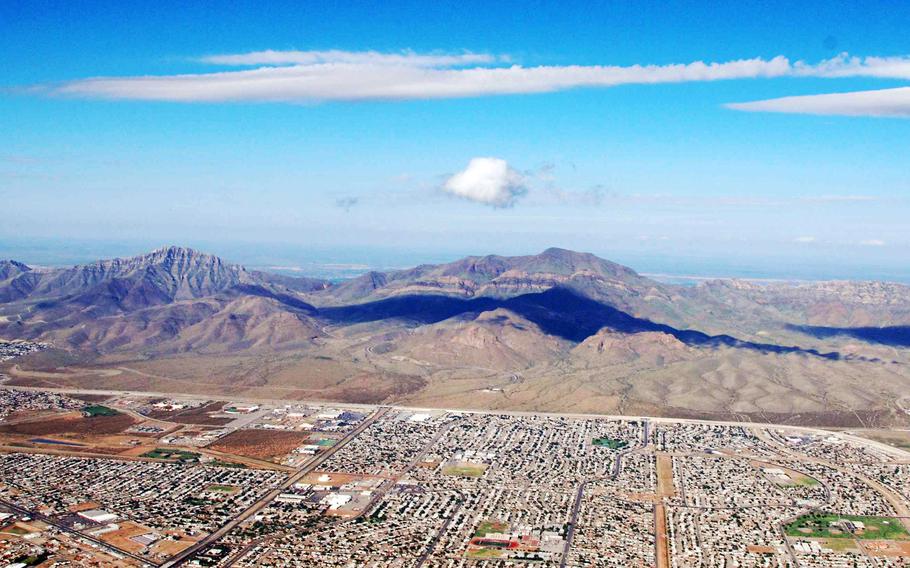
An aerial view of Castner Range as it connects to the city of El Paso, Texas. The range is a noncontiguous piece of Fort Bliss that was last used by the Army as a firing range in 1966. (Scott Cutler for The Frontera Land Alliance)
In early December, a joyful group assembled at the El Paso Museum of Archaeology in Texas for a private unveiling of the newly-curated Castner Range National Monument exhibit. Artifacts ran the gamut from indigenous tools to biodiversity collections to numerous historical pieces and photos contributed by the Army from Castner Range’s time as a live fire hub over a half-century ago. This was not the first such gathering since President Joe Biden signed the protective bill into law on March 21: formal celebrations, mural unveilings, and numerous community engagement sessions have followed, each positive and focused on the work still to be done. The Department of Defense retains full authority and control over this national monument until the estimated 4,000 additional pieces of unexploded ordnance have been removed from the many unsurveyed portions of the 7,000-acre land.
As I stood among the assembled brass and political appointees and local conservationists, I was struck with the notion that we should be doing more of this.
While this specific hierarchical configuration may be novel, our nation may have found a model that works: defense conservation and land remediation.
I’m not suggesting the Department of Defense should assume conservation as a primary mission, but the ongoing Castner Range cleanup and community engagement process provides a tangible example of success. Grassroots efforts in El Paso led by the Frontera Land Alliance had advocated for the protection of Castner Range since the 1980s, but this process took champions: leaders like Undersecretary of the Army Gabe Camarillo and Rep. Veronica Escobar, D-Texas, for their deep understanding of what the land means to the city, and Secretary of the Interior Deb Haaland, a Cabinet member with the necessary influence to get the bill on the president’s desk.
All of the estimated 8.8 million acres of land owned by the Department of Defense (2018 figure) already face some level of environmental management while simultaneously providing pockets of key habitat. My own time at Eglin Air Force Base, Fla., and its hundreds of thousands of acres of endangered longleaf pine forests taught me about the DOD’s commitment to conserving its land and threatened species (like the red-cockaded woodpecker or gopher tortoise). For those unused lands of most critical need to protect or that hold strongest community advocacy, the Castner Range model can be applied.
The benefits for the Army and DOD are twofold. First, by returning this unused land to its natural state, DOD fiscally and operationally unburdens itself from the long-term management and liability concerns that come from unexploded ordnance beside an oft-used state park. Second, the goodwill generated among Fort Bliss, Texas, the Pentagon, the city of El Paso, and everyone involved cannot be quantified in simple metrics, but is palpable at every interaction. The camaraderie created among these diverse groups provides uncanny echoes of my own time in service. More than anything, people are excited about preserving Castner Range and the educational, recreational and research opportunities it presents.
All of us that have worn the uniform swore an oath to defend the Constitution against all enemies, foreign or domestic, but what about the land itself? What about this gorgeous continent of stunning landscapes and unparalleled natural beauty?
Regardless of the sordid history of forcible takeover from Indigenous nations, for which we can never fully recompense those First Peoples, we as modern Americans are the stewards of this magnificent land from sea to shining sea. Each of us has our own image of this wild American perfection: craggy peaks towering above the desert, hidden glacial melt lakes amid the North Woods, sandy beaches on the turquoise Gulf, striated canyons molded into irreplicable shapes by wind and water and time … our landscapes to protect and defend.
Nearly 10 years ago, upon first observing Castner Range from my home in northeast El Paso, I was struck by the beauty of that desert sierra: the way the rising sun paints its slopes in brilliant siennas and ochres each morning; the way the setting sun crests above North Franklin peak at the winter solstice and Anthony’s Nose during the summer one; the way a rare snow blankets the ridgeline in brilliant white; and, above all, the unique opportunity to explore each arroyo and mountaintop to discover their hidden secrets, all within city limits.
It was another veteran who inspired me to do something, the late Judy Ackerman, a retired sergeant major whose years of efforts were finally rewarded even if she didn’t live to see them come to fruition. Judy will live on in memoriam through her section of the museum exhibit and with her name adorning the first public trail when cleanup completes. May we all elevate stewardship of this great land as a key mandate of its defense.
Jon Rezendes is a conservation writer and advocate based in El Paso, Texas. He is a disabled veteran, a 2009 graduate of West Point, and a former combat platoon leader in the 101st Airborne Division, Ranger instructor at the Florida Phase of Ranger School, and company commander in the 1st Armored Division. He is also a member of the board of directors for The Frontera Land Alliance and Texas Lobo Coalition. All opinions contained herein are the author’s own and do not reflect the opinions of The Frontera Land Alliance, Castner Range Forever, Castner Range National Monument, or any other entity.